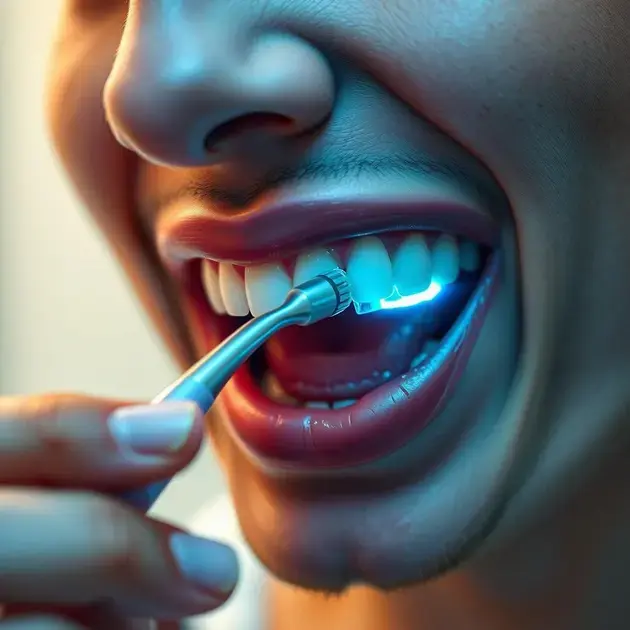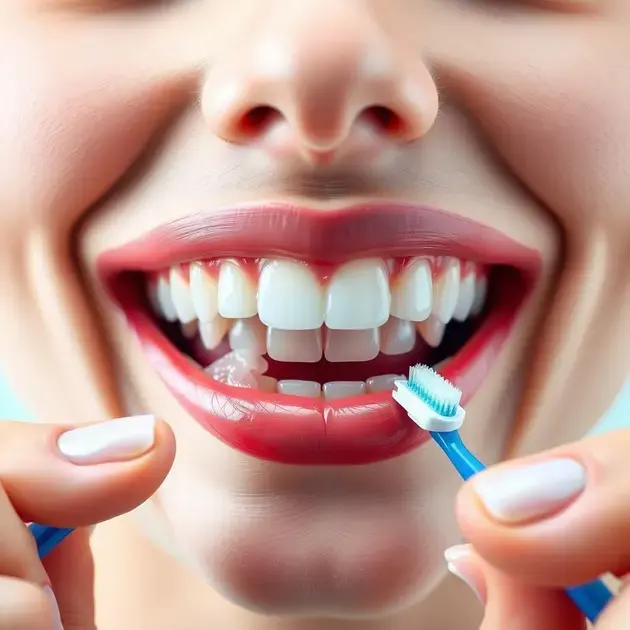Maintaining oral hygiene is crucial for overall health, and removing dental plaque is an essential part of it. Plaque, a sticky film of bacteria that forms on your teeth, can lead to serious dental issues like cavities and gum disease if not properly managed. Our step-by-step guide will walk you through effective strategies to keep your teeth clean and your smile bright.
Recent advancements in dental care technology provide us with various tools and techniques to combat plaque more efficiently than ever. From the correct way to brush and floss to choosing the right dental products, we’ll cover all the bases to help you maintain optimal dental health. Let’s dive into the practices that professionals recommend and why they are successful.

Effective Dental Plaque Removal Techniques
Dental plaque removal is essential for maintaining good oral health and preventing dental issues such as cavities and gum disease. Here are some effective techniques to help you remove plaque effectively:
1. Brushing Technique:
Proper brushing technique is crucial for plaque removal. Use a soft-bristled toothbrush and fluoride toothpaste. Hold the toothbrush at a 45-degree angle to the gums and brush gently in circular motions. Make sure to brush all surfaces of the teeth, including the outer, inner, and chewing surfaces.
To ensure thorough plaque removal, divide your mouth into four quadrants and spend at least 30 seconds brushing each quadrant. Don’t forget to brush your tongue as well to remove bacteria and freshen your breath.
For a more effective clean, consider using an electric toothbrush with oscillating or rotating bristles. These toothbrushes have been shown to remove more plaque than manual ones.
2. Flossing Technique:
In addition to brushing, flossing is crucial for removing plaque from between the teeth and along the gumline. Use a piece of dental floss about 18 inches long and wrap it around your fingers, leaving a few inches in between to work with.
Gently insert the floss between your teeth and curve it into a “C” shape around each tooth. Slide the floss up and down to remove plaque and debris. Be careful not to snap the floss into your gums, as this can cause irritation.
If you find traditional flossing challenging, consider using a water flosser. This device uses a stream of water to remove plaque and food particles from between your teeth, providing a gentle and effective cleaning experience.
Mastering the Art of Brushing and Flossing
Brushing and flossing are the cornerstone of good oral hygiene. Mastering the art of these daily habits can help you maintain a healthy smile and prevent dental problems. Here’s how you can improve your brushing and flossing techniques:
1. Establish a Routine:
Set a routine for brushing and flossing your teeth. Aim to brush at least twice a day and floss at least once a day. Choose a time that works for you, whether it’s after breakfast and before bed or after dinner. Consistency is key to mastering these habits.
You can use apps like “Brush DJ” to help you time your brushing sessions and play music to make the process more enjoyable. This can also ensure that you brush for the recommended two minutes each time.
2. Practice Proper Technique:
When brushing, focus on using gentle circular motions to clean all surfaces of your teeth. Avoid brushing too hard, as this can damage the enamel and irritate your gums. Incorporate a tongue scraper into your routine to remove bacteria from the tongue’s surface.
For flossing, take your time to clean between each tooth thoroughly. If traditional flossing is challenging, try using floss picks or interdental brushes to make the process easier and more effective.
Choosing the Right Dental Products
Using the right dental products can make a significant difference in your oral health. With so many options available, here’s how you can choose the best dental products for your needs:
1. Consult Your Dentist:
Before selecting dental products, consult your dentist for recommendations based on your oral health needs. Your dentist can advise you on the best toothpaste, mouthwash, toothbrush, and floss for your specific conditions, such as sensitivity or gum disease.
Websites like “Colgate Professional” provide valuable information on dental products recommended by dental professionals, helping you make informed choices for your oral care routine.
2. Look for Key Ingredients:
When choosing toothpaste, look for fluoride as a key ingredient, as it helps strengthen enamel and prevent cavities. If you have sensitive teeth, opt for a toothpaste designed for sensitivity with ingredients like potassium nitrate.
For mouthwash, consider products with antibacterial properties like chlorhexidine or essential oils to help reduce plaque and gingivitis. Mouthwash brands like “Listerine” offer a wide range of options tailored to different oral health needs.

The Importance of Regular Dental Cleanings
Regular dental cleanings are a crucial aspect of maintaining good oral hygiene. These cleanings help remove plaque and tartar buildup, which can lead to tooth decay and gum disease if left untreated. During a cleaning, a dental hygienist will use special tools to scrape away plaque and tartar from your teeth, especially in hard-to-reach areas that are difficult to clean with regular brushing and flossing.
By scheduling regular dental cleanings, you can prevent the development of cavities and gum disease, both of which can be painful and costly to treat. Additionally, cleanings can help detect any oral health issues early on, allowing for prompt intervention and treatment.
Experts recommend visiting your dentist for a cleaning at least twice a year, or more frequently if you have specific oral health concerns. These routine cleanings not only improve your oral health but also contribute to your overall well-being.
Remember, prevention is key when it comes to oral health, and regular dental cleanings are an essential part of maintaining a healthy smile.
Preventing Dental Plaque Build-Up
Dental plaque is a sticky film of bacteria that forms on your teeth and can lead to various oral health issues if not properly managed. To prevent plaque build-up, it is essential to practice good oral hygiene habits, such as brushing your teeth twice a day and flossing daily.
In addition to regular brushing and flossing, using an antimicrobial mouthwash can help reduce the amount of bacteria in your mouth and prevent plaque formation. It is also important to maintain a balanced diet and limit sugary and acidic foods and drinks, as these can contribute to plaque build-up and tooth decay.
Visiting your dentist for regular cleanings is another critical step in preventing dental plaque build-up. A dental professional can remove any hardened plaque, known as tartar, that cannot be removed through regular brushing and flossing.
By incorporating these measures into your oral care routine, you can effectively prevent dental plaque build-up and maintain optimal oral health.
Healthy Habits for Maintaining Oral Hygiene
Maintaining good oral hygiene is essential for overall health and well-being. In addition to regular dental cleanings and preventing dental plaque build-up, there are several healthy habits you can incorporate into your daily routine to support optimal oral health.
First and foremost, be sure to brush your teeth at least twice a day with fluoride toothpaste to remove plaque and prevent tooth decay. It is also important to replace your toothbrush every three to four months or sooner if the bristles are frayed.
Flossing daily is another crucial habit for maintaining oral hygiene, as it helps remove food particles and plaque from between your teeth where your toothbrush cannot reach. Additionally, be mindful of your diet and try to limit sugary snacks and beverages that can contribute to dental plaque build-up.
Finally, be sure to schedule regular dental check-ups with your dentist to monitor your oral health and address any issues early on. By following these healthy habits, you can maintain a healthy smile and prevent common dental problems.
Conclusion
In essence, regular dental cleanings play a pivotal role in upholding excellent oral hygiene by eliminating plaque and tartar build-up, which can precipitate tooth decay and gum disease if unattended. These cleanings ensure the removal of these harmful substances from areas challenging to reach through daily brushing and flossing, safeguarding your dental well-being.
By adhering to a biannual dental cleaning schedule, you not only avert cavities and gum disease, which can be excruciating and financially taxing to rectify, but also enable the early detection of any emerging oral health issues for timely intervention. It is recommended to consult your dentist at least twice a year, or more frequently if specific concerns arise, as such routine cleanings not only enhance your oral health but also contribute to your overall vitality.
Undoubtedly, prevention stands as the cornerstone of oral health, with regular dental cleanings constituting an indispensable component in preserving a radiant smile. Beyond these cleanings, incorporating habits like brushing with fluoride toothpaste, flossing daily, and maintaining a diet low in sugary and acidic foods bolsters your oral care regimen. Additionally, replacing your toothbrush regularly, alongside scheduling routine dental check-ups, fortifies your arsenal against dental plaque build-up and common oral maladies, ensuring sustained oral wellness and a beautiful smile for years to come.
